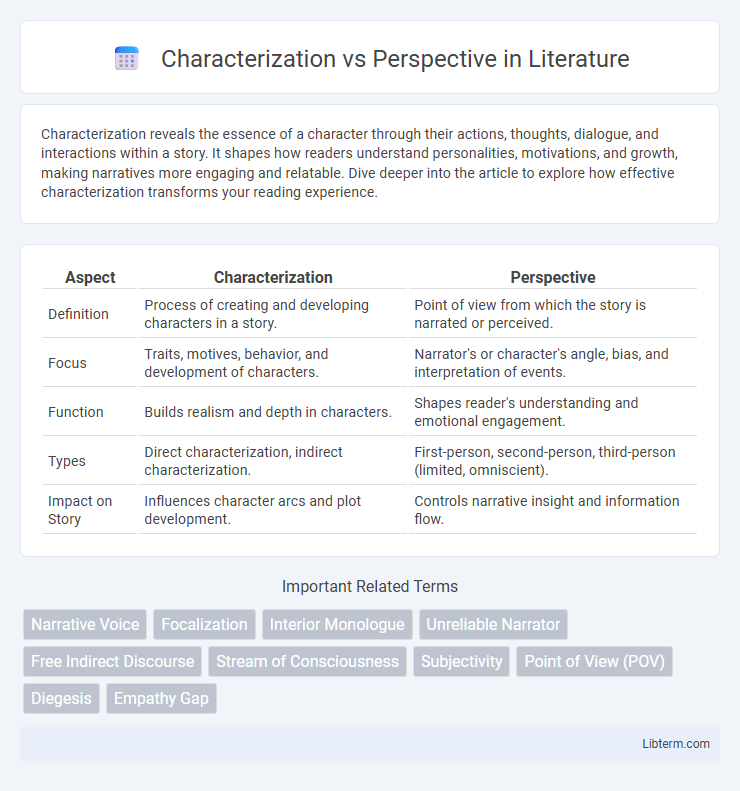Characterization reveals the essence of a character through their actions, thoughts, dialogue, and interactions within a story. It shapes how readers understand personalities, motivations, and growth, making narratives more engaging and relatable. Dive deeper into the article to explore how effective characterization transforms your reading experience.
Table of Comparison
| Aspect | Characterization | Perspective |
|---|---|---|
| Definition | Process of creating and developing characters in a story. | Point of view from which the story is narrated or perceived. |
| Focus | Traits, motives, behavior, and development of characters. | Narrator's or character's angle, bias, and interpretation of events. |
| Function | Builds realism and depth in characters. | Shapes reader's understanding and emotional engagement. |
| Types | Direct characterization, indirect characterization. | First-person, second-person, third-person (limited, omniscient). |
| Impact on Story | Influences character arcs and plot development. | Controls narrative insight and information flow. |
Defining Characterization and Perspective
Characterization refers to the methods an author uses to develop and reveal a character's traits, motivations, and personality through actions, dialogue, and description. Perspective, or point of view, defines the vantage point from which the story is narrated, influencing how events and characters are perceived by the reader. Together, characterization and perspective shape the depth and reliability of narrative interpretation, impacting reader engagement and understanding.
Key Differences Between Characterization and Perspective
Characterization involves the development and portrayal of a character's traits, motivations, and personality within a narrative, while perspective refers to the viewpoint or angle from which the story is told, affecting how events and characters are perceived. Characterization shapes the depth and complexity of fictional individuals, whereas perspective influences the reader's interpretation and understanding of the plot and other characters. The key difference lies in characterization focusing on who the characters are internally, and perspective focusing on the external lens through which the story unfolds.
The Role of Characterization in Storytelling
Characterization shapes the depth and authenticity of characters, driving emotional engagement and plot development in storytelling. Effective characterization reveals motivations, conflicts, and growth, making narratives relatable and compelling. This process anchors perspectives, allowing readers to experience the story through richly developed viewpoints.
How Perspective Shapes Narrative
Perspective profoundly shapes narrative by controlling the lens through which characters and events are interpreted, influencing readers' emotional engagement and understanding. Characterization develops personalities, motives, and complexities, but perspective dictates the narrative focus, bias, and reliability, ultimately molding the story's meaning and tone. First-person perspectives offer intimate insights and subjective realities, while third-person perspectives provide broader context and varying degrees of objectivity.
Techniques for Developing Characterization
Techniques for developing characterization include direct description, where the author explicitly outlines a character's traits, and indirect methods such as dialogue, actions, and inner thoughts that reveal personality subtly. Writers use physical appearance, speech patterns, and behavior to deepen character complexity and create authenticity. Perspective influences characterization by determining how much insight the narrative provides into a character's motives and emotions, shaping reader understanding.
Types of Perspective in Literature
Types of perspective in literature include first-person, second-person, and third-person viewpoints, each shaping the reader's understanding differently. First-person perspective provides intimate insight through a character's direct thoughts and feelings, while third-person perspective offers an external, often omniscient, overview of multiple characters and events. Second-person perspective, though less common, immerses the reader by addressing them as the protagonist, creating a unique narrative experience distinct from characterization techniques.
The Interplay Between Characterization and Perspective
Characterization shapes a narrative by revealing traits, motivations, and growth of characters, while perspective influences how these elements are perceived and interpreted by the audience. The interplay between characterization and perspective creates a dynamic storytelling experience, where a character's identity is not only defined by their attributes but also by the narrative viewpoint through which their story is told. Different perspectives can highlight contrasting facets of a character, enriching the depth and complexity of the narrative.
Effects on Reader Engagement
Characterization shapes reader engagement by deepening emotional connections through detailed personality traits and motives, fostering empathy and sustained interest. Perspective controls reader engagement by filtering the narrative through a specific lens, influencing bias, accessibility, and immersion in the story world. Combined, rich characterization and distinct perspective enhance immersive experiences and emotional investment, driving active reader involvement.
Common Mistakes in Handling Characterization and Perspective
Common mistakes in handling characterization and perspective include confusing a character's traits with the narrator's viewpoint, leading to inconsistent narrative voices. Writers often fail to maintain a clear distinction between character development and the narrative perspective, which can result in unreliable or unclear storytelling. Mismanaging these elements disrupts reader engagement by blending internal character experiences with external narration improperly.
Enhancing Your Writing: Balancing Characterization and Perspective
Balancing characterization and perspective enhances your writing by creating immersive and relatable narratives. Detailed characterization brings depth to your characters' motivations, emotions, and development, while varied narrative perspectives offer fresh insights and maintain reader engagement. Integrating both elements effectively ensures a nuanced story that resonates on multiple levels.
Characterization Infographic

 libterm.com
libterm.com